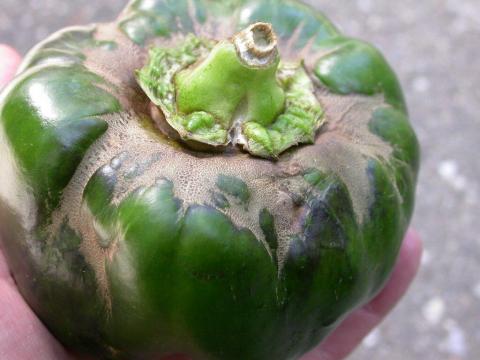Broad Mites in Pepper

Broad mites can cause serious economic injury to a wide range of crops, including annuals, cut flowers, small fruit crops and a wide range of other fruiting vegetable crops. However, we’ve been hearing from an increasing number of growers about broad mite affecting pepper transplants and pepper crops grown in high tunnel production systems. We thought it was worth addressing this issue with a brief blog post but please reach out with questions and concerns by emailing anna.wallingford@unh.edu or read more on on avoiding, identifying, and managing broad mite infestations in this post on general biology and identification, this post from Dan Gilrein on broad mites in greenhouse crops, this post from Steve Bogash about managing broad mites in open culture pepper crops, and this post about using predatory mites in tunnel systems.
Identification is challenging because this group is particularly good at hiding in plant material or soil and may not be easily observed. Even with excellent magnification tools, proper identification requires some experience. Symptoms of infestation include distortion and stunting of new growth, and can be easily mistaken for various plant diseases, herbicide damage, and a number of other environmental issues. Left unchecked, broad mite infestations lead to conspicuous scaring of pepper fruit and potentially complete crop loss.
Broad mites and cyclamen mites (tarsonemid mites) are in a group separate from two-spotted spider mites (tetranycid mites), spinach crown mite (acarid mites), and rust mites (eriophyid mites). Therefore recommendations for management may be a little different from group to group. Certain miticides will differ in their efficacy to control these groups. For example, Kanemite (acequinocyl) is highly rated for two-spotted spider mite but does not work well for broad mite control. Broad mite infestations often cause more severe damage to crop plants than other mite groups, so best practice can sometimes be the destruction of the crop rather than remediation of the pest. This is often the case when infestations are identified when crops are fruiting, so prevention and early interventions are best.
Vegetable Transplants
Because of the challenges associated with early identification, any indication of potential mite infestation should trigger action in treating vegetable transplants. Early indication of infestation might include a history of infestation or information gained from your supplier about potential infestation. Products registered for use on transplants include Pylon (chlorfenapyr), Kontos (spirotetramat), as well as several neonicotioids, e.g. TriStar (acetamiprid), Marathon (imidacloprid), Flagship (thiamethoxam). See labels for rates of application and other restrictions on their uses.
Many products containing azadirachtin are registered for use on transplants (e.g. Azaguard). This active ingredient does not act to eliminate mite populations and will likely not achieve desired control for transplants. However, azadirachtin acts as a growth regulator and may be an effective non-toxic approach for suppressing suspected broad mite infestations in planted crops, if applied early and often.
High Tunnel Production
Biological control is a promising non-toxic approach, if action is taken early and often. Grandevo, Venerate, and Met 52 are biopesticides with some demonstrated efficacy on broad mite. Commercially available predatory mites, e.g. Neoseiulus (synonym Amblyseius) cucumeris, N. californicus, have been demonstrated to suppress broad mite populations. Biocontrols should be applied at planting if the planting site has a history of broad-mite infestations. Follow-up applications/introductions should also be considered until plants have matured. Care should be taken when integrating biocontrol with chemical fungicides and insecticides. Allow proper time between foliar chemical applications and applications/releases of biological controls to avoid negative non-target effects.
There are many products with efficacy on broad mites that are registered for use on pepper (listed below). When you are making applications in a high tunnel, take care not to use products whose label explicitly states that they are not for use on in greenhouses. For example, Portal XLO (fenpyroxlmate) is labeled for pepper but has restrictions on other crops grown in protected culture. A close reading of the label is always critical.
Portal XLO (fenpyroxlmate), Oberon (spiromesifen), and Torac (tolfenpyrad) are rated a little higher in terms of broad mite efficacy, but may also have negative, lasting impacts on predatory mites. Sulfur products approved for organic production (e.g. Microthiol Disperss) are moderately effective, especially with regular application. You might consider balancing non-target impacts when selecting products. For example, Agri-Mek (abamectin) and Movento (spirotetramat) are “softer” on non-targets but rated only moderately efficacious on broad mite.
Use of a spreader sticker is recommended with foliar applications as excellent coverage is essential for control of these tiny arthropods. There are some label restrictions on the types of spreader-stickers that can be used with certain products, so take care to read your label.
Inclusion or exclusion of commercial products does not indicate endorsement.

